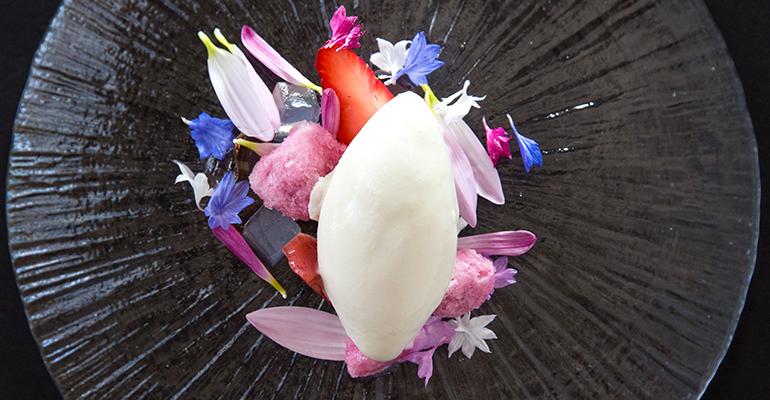Beauty, taste and fragrance all play a role in the flowers selected to adorn seasonal dishes.
Chefs across the country are highlighting their love for botanicals with flowers that do more than garnish a plate. Hibiscus, lavender, violas, pansies and roses are not only beautiful, but delicious. And the blossoms that spring forth from herbs such as basil, cilantro, chive and dill are also surprisingly tasty edibles that mirror the taste of their parent plants.
“Herb flowers really taste like the herb they come from,” said Richmond Edes, executive chef of Temple Bar in Cambridge, Mass. “Arugula flowers have that peppery arugula flavor, and chive flowers have an onion taste.”
“As far as edible flowers, nasturtiums are pretty strong,” Edes said. “They have a kind of lemony, peppery flavor to them. One of my favorites is borage, which has a subtle melon flavor, and it’s very easy to grow.”
While edible flowers are not new to the culinary world, the edible flower industry has experienced a surge in recent years, thanks in part to online recipes and cooking shows that highlight their use. Some of the more popular blooms are violas, pansies, bachelor buttons, calendula, marigolds and nasturtiums.
Is an edible garden right for your restaurant? We asked four chefs to share insights about their own.
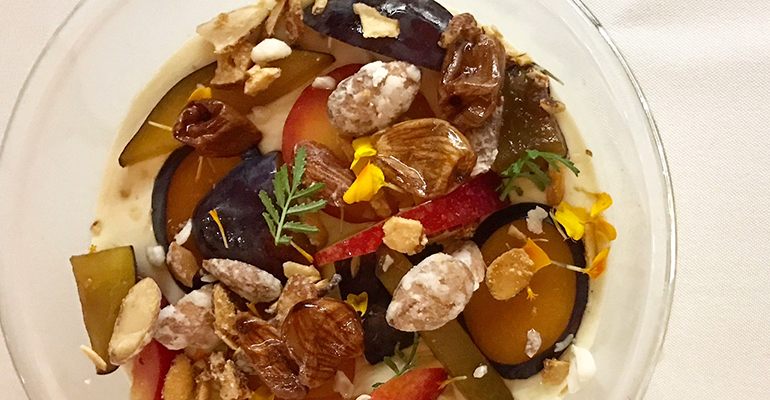
Starting an edible garden
If you have outdoor space and a bit of a green thumb, growing your own edibles can be the most convenient way to use flowers on your menu, while also reducing your environmental footprint.
“We’re currently growing two types of hyssop, citrus marigolds, lavender, two types of geranium, nasturtium and oxalis, and we're hoping that the fennel, rosemary, sage and dill will sprout flowers as well,” said Anna Posey, co-owner of Elske in Chicago. “We chose them because of their taste. They all have flavors we like and will hopefully enhance our dishes, not just be a pretty accent.”
While Elske has space to grow both outdoors and inside, it avoids plants that attract insects or animals, Posey noted. She offered a tip for those considering growing flowers in a space where guests will gather.
“We avoided some flowers to keep bees and butterflies to a minimum — they’re beautiful, but not convenient to guests eating on the patio,” she said.
At Temple Bar, Edes is growing flowers and the herbs that sprout them.
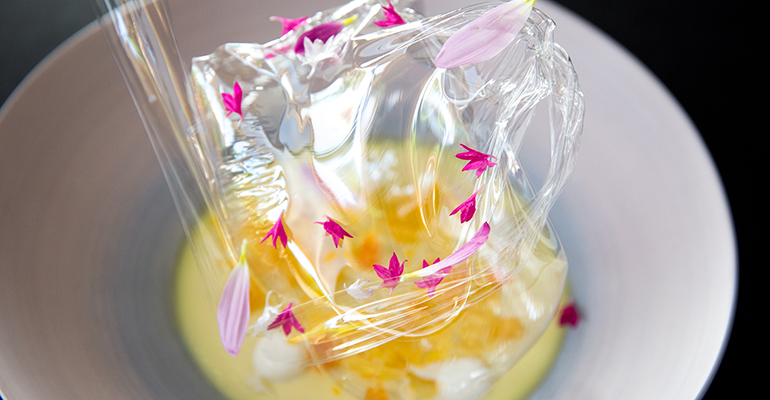
“This year we’re growing nasturtiums, bachelor buttons and borage,” he said. “A lot of the other ones are herb flowers such as thyme, fennel, marjoram and basil.”
At Crystal Springs Resort in Sussex, N.J., executive chef Anthony Bucco describes the location as “essentially in the forest,” naturally lending itself to gardening. Bucco manages several restaurants, including a seasonal outdoor venue set up inside the property’s garden.
“I have a lot of foraged flowers and invasives such as dandelions,” he said. “In our chef’s garden, we’re growing nasturtium, violas, and marigolds. I also use strawberry blossoms for teas and fish.”
Choosing your flowers
There are dozens of edibles to choose from, but the ones that are appropriate for your menu will depend on the application. Taste each one on its own and pair the petals with various dishes — both sweet and savory — before making a final decision.
“The best edible flowers are usually the blossoming herbs, but if I had to choose a flower, it would be the flower from a giant purple oxalis plant,” said executive chef Steven Greene of Herons restaurant, inside The Umstead Hotel and Spa in Cary, N.C. More than 20 types of edible plants are grown at a nearby farm owned by the hotel.
Posey of Elske also shared her favorite picks.
“I love the citrus marigolds. They have such a bright taste and are so great with stone fruits and citruses,” she said. “I'm also really into lavender and geranium right now.”
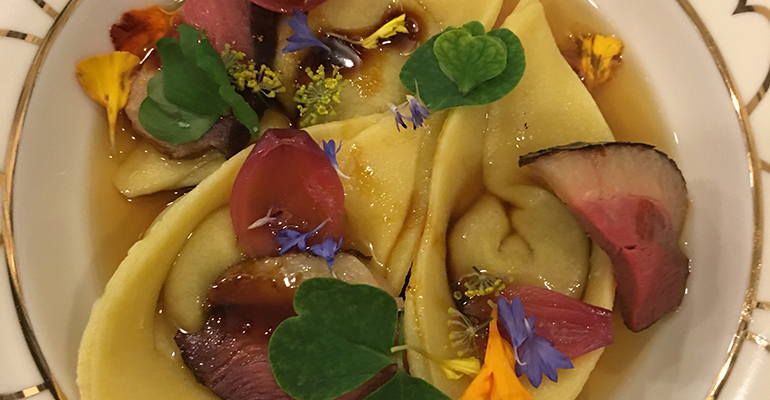
Perfect pairings
As consumers have become more open to new flavors and experiences, chefs have gradually started pairing an increasing number of flower varieties into all types of dishes and cocktails. In the past, flowers may have been a pretty addition to a dish; now they lend a distinct flavor profile to entrées, desserts and beverages.
“With herb flowers, because they’re stronger, you can pair them with pastas, tomato salads, and fish,” Edes of Temple Bar said. “It needs to be visually appealing, but also add flavor that makes someone say something like, ‘Wow, that little thing tastes like fennel.’”
“We make cultured butters such as marigold butters and dandelion butters using the petals,” said Bucco of Crystal Springs Resort. “Some people call marigold the poor man’s saffron, and the flower really does give off a nice flavor, which is kind of sweet and bitter.”
“Nasturtiums are not only beautiful, they’re great for a lot of savory applications,” Bucco added. “They give off a radish-like quality, which is great for raw fish items or anything from a beef tartare standpoint.”
Bucco recommended using marigolds and dandelions in infusions, to minimize some of the bitterness of the flowers.
“We’ll do something like a dandelion ice cream with a first-of-the-season honey,” he said.
Greene said he leans toward pastry with edible flowers.
“I think it depends on the ingredients in the dish,” he said. “Don’t overdo it, and try not to use the whole flower. I use the petals, so the flavor isn’t overwhelming.”
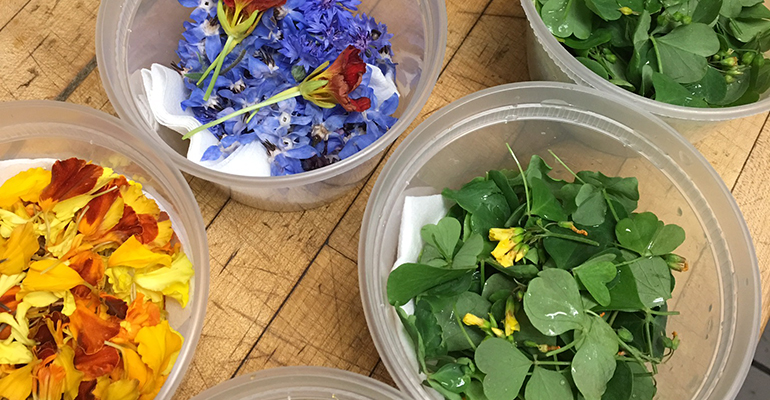
Growing great kitchens
“I think growing edibles is good from a chef’s standpoint because it helps to educate our staff,” Edes said. “When the staff comes in, they walk right by the planters in the back parking lot. Seeing the plants usually makes them curious about what’s growing, and they want to help.”
Garnishes can also help with practical matters, Bucco said.
“For example, with the strawberry plant, you can use its blossoms, its leaves and the fruit,” he said. “When you can build dishes around what’s available from the plant, it’s pretty fun.”
Whether growing your own edibles or sourcing them from local, organic farms, think about how the taste, fragrance and esthetic of each bloom can work to enhance your own culinary creations.

